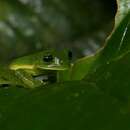Description
provided by AmphibiaWeb articles
The head of Centrolene ballux is slightly wider than its body, with that width being an average of 37% of total snout-vent length. Its rather short snout appears bluntly rounded, both in dorsal and lateral view. The snout-vent length for males ranges from 19.2 - 22.2 mm, whereas for females the snout-vent length ranges from 21.0 - 23.3 mm. It possesses moderately large eyes that protrude anterolaterally. Its nostrils are two-thirds of the distance from eyes to the end of the snout and also protrude anterolaterally. There are visible elements of tympanums, and no supratympanic fold. The first finger is shorter than the second, whereas the fourth finger is longer than the second. Webbing is not strongly developed and is completely absent between the first and second digits. The hind limbs are slender, and any tubercles on lower extremities are rather small or completely absent. The texture of the skin is smooth on the dorsal surface, and ranges from smooth to granular on the ventral surface. The anal opening is situated at the upper thigh region and is directed posteriorly (Duellman and Burrowes 1989).This species is distinguished from others in its genus by its lack of vomerine teeth (possessed by other species of Centrolene, e.g. C. prosoblepon) and its bright coloration. The color is a dark lime green with characteristic golden flecks speckling the dorsal surface. No other species of Centrolene possesses such coloration with golden flecks (Duellman and Burrowes 1989). In life, the color of this frog is a rather dark lime on the dorsum, and has noticeable golden flecks distributed throughout. The visceral peritoneum is transparent, presenting a clear view of distinctly green bones (Duellman and Burrowes, 1989). In preservative, the green dorsal coloration comes out as a shade of lavender with the flecks turning to white (Duellman and Burrowes 1989).Variation in this species has not been described.The species authority is: Duellman, W.E. and Burrowes, P.A. (1989). New species of frogs, Centrolenella, from the Pacific versant of Ecuador and southern Colombia. Occasional Papers of the Museum of Natural History of the University of Kansas 132:1–14.Centrolene ballux shares a close evolutionary relationship with Centrolene buckleyi, a larger species found in similar regions but at higher elevations (Catenazzi et al. 2012).The specific name, ballux, literally means “gold dust” in Latin. This refers to the golden flecks strewn across the frog’s dorsal surface (Dulleman and Burrows 1989).
- Bolívar, W., Coloma, L.A., Ron, S., Cisneros-Heredia, D. Wild, E. (2004). Centrolene ballux. In IUCN Red List of Threatened Species. Version 2012.1. www.iucnredlist.org. Downloaded May 2015
- Catenazzi, A., Von May, R., Lehr, E., Gagliardi-Urrutia, G., Guayasamin, J.M. (2012). ''A new, high-elevation glassfrog (Anura: Centrolenidae) from Manu National Park, southern Peru.'' Zootaxa, 3388, 56-68.
- Duellman, W.E. and Burrowes, P.A. (1989). ''New species of frogs, Centrolenella, from the Pacific versant of Ecuador and southern Colombia.'' Occasional Papers of the Museum of Natural History of the University of Kansas, 132, 1-14.
- Hutter, C. R., Guayasamin, J. M. (2012). ''A New Cryptic Species of Glassfrog (Centrolenidae: Nymphargus) from Reserva Las Gralarias, Ecuador.'' Zootaxa, 3257, 1-21.
- author
- Ethan Maxwell Grossman
Distribution and Habitat
provided by AmphibiaWeb articles
When first described, Centrolene ballux was sighted in three main localities across the Pacific versant of southern Colombia and northern Ecuador. It is limited to humid mountain forests at elevations of 1700 – 2010 m (Duellman and Burrowes 1989). However it is no longer found at the Saloya River Valley, Ecuador sites (Bolívar et al 2004). In Ecuador, this frog has recently been sighted at Reserva Las Gralarias and the Canchupi river, and rarely elsewhere. Individuals can be found at night on vegetation surrounding rivers, streams, and roadside ditches (Hutter and Guayasamin 2012).
- author
- Ethan Maxwell Grossman
Life History, Abundance, Activity, and Special Behaviors
provided by AmphibiaWeb articles
Centrolene ballux is active at night, and is found on leaf surfaces of ferns or bushes 0.5 – 2.0 m above small bodies of water. Males emit a distinct single high-pitched trill during the rainy season as its mating call. Females will place egg clutches of around twenty or so eggs on leaves hanging above fast-flowing streams or rivers. The eggs are gelatinous, and are clear and sometimes green in coloration. Males have been found nearby egg clutches (Duellman and Burrowes 1989).
- author
- Ethan Maxwell Grossman
Life History, Abundance, Activity, and Special Behaviors
provided by AmphibiaWeb articles
Considering that C. ballux is found in such a small number of disjunct localities and a rather narrow altitudinal range, it is listed as Critically Endangered. The quality of its habitat is continually declining from various threats, most of them artificial. These include climate change (causing reduction in humidity), habitat destruction, deforestation, introduction of trout to nearby water sources, contamination of water, and the emergence of various infectious diseases (Bolívar et al. 2004). Within Ecuador, reproductive populations are only known to be found at Reserva Las Gracias, the Canchupi river, and Estación Científica Guajalito (Bolívar et al. 2004, Hutter and Guayasamin 2012).Centrolene ballux were found on the privately owned Reserva La Planada in Colombia, however recent surveys have not been conducted to determine if they are still present (Bolívar et al. 2004).
- author
- Ethan Maxwell Grossman
Centrolene ballux: Brief Summary
provided by wikipedia EN
Centrolene ballux is a species of frog in the family Centrolenidae. It is known from a few disjunct localities on the Pacific versant of the Cordillera Occidental in southern Colombia (Nariño Department) and northern Ecuador (Pichincha and Santo Domingo de los Tsáchilas Provinces). Common names golden-flecked glassfrog and Burrowes' giant glass frog have been coined for it.
- license
- cc-by-sa-3.0
- copyright
- Wikipedia authors and editors

